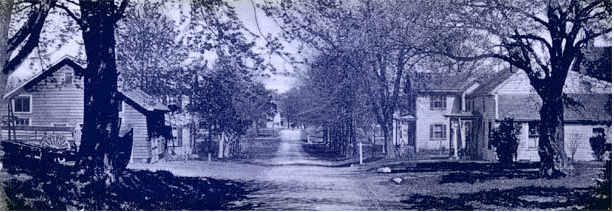Long Hill Township Historical Society

Provided by the Morris County Heritage Commission, 2003 Long Hill Road, Millington looking east from Basking Ridge Road – 1908 postcard photo courtesy of Dale Monetti
LONG HILL TOWNSHIP, AN INTRODUCTORY HISTORY
The Township of Long Hill was established in 1866 as Passaic Township. It lies along the Passaic River and extends farther south than any other portion of Morris County. Passaic is the Indian word for “valley”. Before 1866, this area was the southern part of Morris Township. In the 1920’s, New Vernon separated from Passaic Township. The township now consists of Gillette, Homestead Park, Meyersville, Millington and Stirling. The five stars on the township seal represent the five villages. During the election in November 1992, by a binding referendum, the residents voted to reclaim the township’s original name of Long Hill due to the Township of Passaic often being confused with the City of Passaic.
Meyersville, the oldest settlement in town, was owned in the 1600s by Joel Bebout. He received the land as a grant from the King of France. The village was named for Kasper W. Meyer, a wealthy landholder in the community, who deeded a tract of land to be used for a German church and cemetery.
Millington was a major settlement begun in the 1730s. It is believed Millington received its name between 1778 and 1833 because of the many mills in the area. A public school was built in the 1800’s, which now served as the Township Hall of Long Hill Township until 2003.
Gillette was named in 1870-1871 by George Howell, an engineer who surveyed for the construction of the West Line Railroad, which ran from Bernardsville to Summit. The railroad was given a right of way for the station and tracks as it passed through the Cornish farm in Passaic Township. Howell named the village Gillette to honor the Cornish family. He had married Rachel Gillette Cornish, and he chose his wife’s middle name for this part of town.
Stirling was settled in 1740. It was named by Fred S. Winston who purchased about 500 acres of land in the area for development. He named the area after Lord Stirling who had owned 1.000 acres of land lying on both skies of the Passaic River. A manufacturing and residential community was developed in the area of the railroad in the decades after the Civil War.
Homestead Park, purchased in the 1730’s, is the easternmost section of the township. Homestead Park was named in 1920 by developer L. Preston Gates. It was one of the first major residential developments in the township.
LONG HILL TOWNSHIP, A BRIEF HISTORY
Long Hill Township, Morris County’s southeastern most municipality, covers 12.1 square miles and has a population of about 8,800. Named for a ridge of the Watchung Mountains, the township also encompasses parts of the Great Swamp and the Passaic River valley.
European settlers first arrived here during the 1730s. They farmed, established mills on the Passaic River in what would become Millington, and used the natural resources of the Great Swamp. The early trail that became Long Hill Road was their principal highway. These scattered settlements became part of Morris Township in 1740, including a region of southern Morris Township known as “Long Hill”.
During the Revolution, local men served in the militia, and householders provided supplies to the troops at Jockey Hollow. The Continental Army placed a beacon at a high point on the long ridge to warn of enemy troop movements.
Throughout much of the nineteenth century, Long Hill was a sparsely populated farming community with centers of activity in the villages of Millington and Meyersville. The latter was named for Kasper Meyer, one of several German immigrant farmers who had arrived here early in the century.
Changes occurred after 1866 when the new municipality of Passaic Township was formed from Morris Township. In 1869 the Passaic Valley and Peapack Railroad purchased rights of way in the valley to extend railroad service from Summit to Bernardsville, and the Mutual Life Insurance Company of New York bought up 500 acres of farmland near the railroad. Here the company developed the factory village of Stirling, named for the revolutionary general William Alexander, known as Lord Stirling, who once owned land here.
The railroad also opened a station to the east on farmland owned by the Cornish family. The line’s engineer named it Gillette to honor his fiance, Rachel Gillette Cornish. Though the railroad brought a new immigrant population to Stirling, Gillette remained rural into the early twentieth century. The area had its own post office and general store.
Passaic Township’s scenic hills and easy access to transportation attracted wealthy people from the city who built summer homes along the ridge overlooking Passaic Valley. A simpler summer colony was built South of Meversville.
At the end of World War 1, Passaic Township covered nearly 33 square miles on both sides of the Great Swamp. The township became its current size in 1922, when northern residents formed the new township of Harding.
In 1992 the community changed its name to Long Hill Township. Today, despite commercial and suburban development, Long Hill has many historic structures ranging from eighteenth century farmhouses to the twenty-first century September 11monument. They remind us of Long Hill’s legacy as a place of villages, farms, mills, and factories, where working men and women of many nationalities contributed to the development of our nation.

